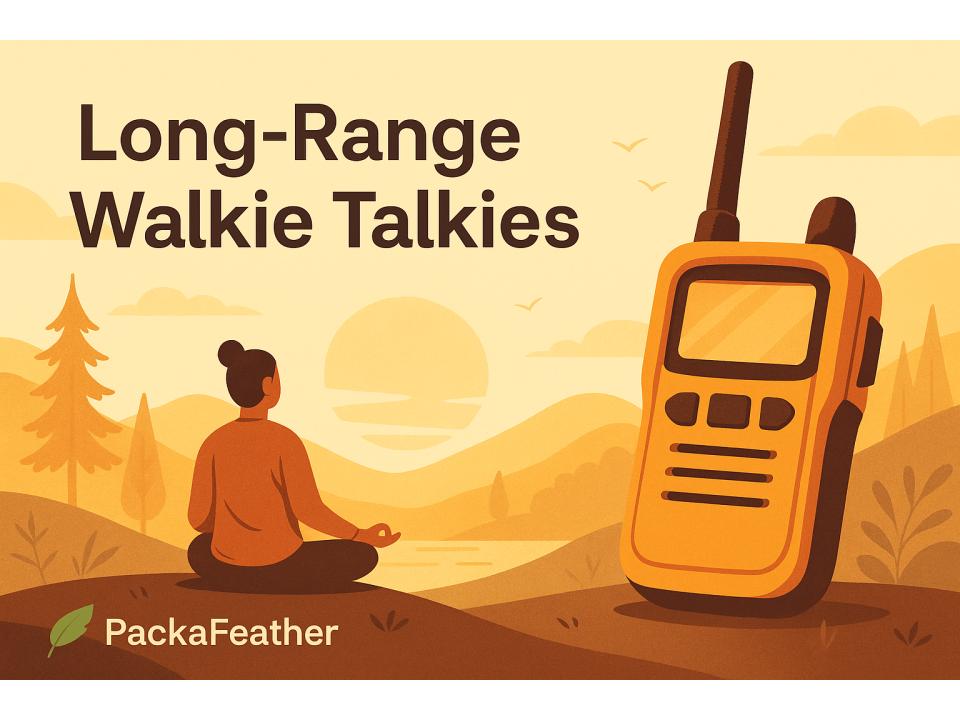📡 In a world that often feels noisy and overloaded, there’s something profoundly grounding about stepping into the wilderness — away from cell towers, away from notifications — and just listening. Listening to the birds, to the wind, and, occasionally, to your hiking partner calling in over a crackling walkie talkie.
Whether you’re trekking across remote trails, guiding a silent retreat, or journeying deep into a national park, reliable communication can be both reassuring and necessary. That’s where long-range walkie talkies come in.
Let’s explore what makes a walkie talkie truly suited for long-distance, off-grid travel, and which models bring peace of mind — without breaking the flow of your spiritual or outdoor journey.
🌲 What Makes a Walkie Talkie “Long Range”?
Manufacturers love to advertise 35, 50, or even 100-mile ranges. But the truth is more grounded. These estimates assume ideal, flat, interference-free conditions — like talking across a lake.
In real-world forested or mountainous terrain, you can expect 1 to 5 miles of reliable range from even the best devices. That’s why choosing a high-quality model matters.
Key considerations:
- Wattage & Power Output: Higher wattage = more range, generally. Look for 2 to 5 watts.
- Antenna Quality: A long, flexible antenna improves both transmit and receive distance.
- Frequencies Used: GMRS radios (licensed in the U.S.) offer more power and channels than FRS.
- Battery Life: For slow-paced, meditative treks, a walkie talkie should last all day, ideally on replaceable AAs or a USB-rechargeable pack.
- Weather Resistance: IP54 or above will protect against dust and light rain — perfect for wandering through misty woods.
🧘♀️ Features to Look For
When connection matters, but serenity does too, consider:
- Silent Mode / Vibration Alerts: Stay in tune with your environment.
- VOX (Voice-Activated Transmission): Hands-free use during hikes.
- Emergency Weather Alerts: Especially useful for backcountry solitude.
- Privacy Codes: Reduce interference from other radio users.
- Channel Scan: Quickly find your group if you get separated.
🧭 Recommended Long-Range Walkie Talkies
| Model | Best For | Range (Real-World) | Price Range | Notable Features |
|---|---|---|---|---|
| Midland GXT1000VP4 | Balanced Power & Features | 2–3 miles | $$ | NOAA alerts, 50 channels, waterproof |
| Motorola T600 H2O | Outdoor Adventures | 1–2 miles | $$ | Floats, waterproof, flashlight |
| Baofeng BF-F8HP | Advanced Users (GMRS/Amateur) | 5–8 miles+ | $$ | Programmable, 8 watts, long antenna |
| Cobra ACXT1035R FLT | Water Excursions | 2–3 miles | $$ | Rewind-Say-Again™, waterproof, floats |
| Retevis RT22 | Budget Urban Use | 0.5–1 mile | $ | Ultra-compact, license-free (FRS) |
🏕️ Choosing the Right One for Your Journey
- Solo Retreats: A compact, easy-to-use model with long battery life (like Motorola T600).
- Group Hikes: Something with multiple channels and strong signal, like the Midland GXT1000.
- Off-Grid Overlanding: A GMRS radio with higher power and an optional repeater for extended range.
- Urban Silence Seekers: Even city explorers can benefit from a walkie talkie — to reconnect without phones.
🌿 Final Thoughts from PackaFeather
Long-range walkie talkies aren’t just for hunters or emergency crews. For spiritual travelers, off-grid nomads, or anyone seeking mindful solitude, they offer just enough tether to the outside world — without pulling you out of your inner one.
At PackaFeather, we believe in intentional communication. Say only what’s needed. Let silence fill the rest.
